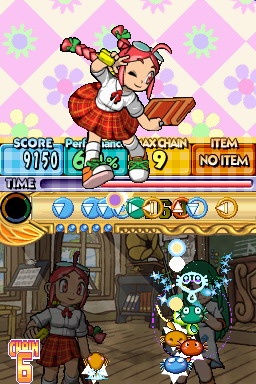Ontamarama is, for lack of a better description, very Japanese. It features an odd mix of frantic tapping and DDR-style button beating, rounded out by crazy-cute anime characters who spout crazy-cute dialogue. It's weird, often fun, and a unique take on the rhythm genre that could work only on the Nintendo DS. Yet the foibles that make it so amusing also make it occasionally frustrating. Additionally, it's a limited package with a very short story mode and no multiplayer, which is an option it absolutely begs for. Yet for all of its idiosyncrasies, Ontamarama is an entertaining game that scratches an admittedly kooky itch.
To be successful at Ontamarama, it helps to have outstanding hand-eye coordination. There's just a ton of stuff going on at any given moment. First, you have to handle the D-pad mashing that is standard to most rhythm games. A series of arrows flows from right to left at the top of the touch screen, and as each arrow passes through the circle in the top left corner, you hit the D pad in the appropriate direction in time with the music. Sound easy? Think again.
You see, you've also got bouncy, bubbly creatures known as ontama that pounce onto the touch screen. Before you can clear an arrow, you need to fill it with an ontama of the matching color by tapping it. This doesn't sound particularly challenging in and of itself, but coordinating the two activities gets to be quite a challenge as the screen fills with ontama and the arrows really start to fly. It's the gaming equivalent of patting your head and rubbing your belly at the same time, and it isn't always an easy task to separate the activities of your left hand from those of your right hand.
However, Ontamarama doesn't stop there. Sometimes long arrows need to be filled in by a group of ontama, which is best accomplished by drawing a circle around them. This isn't always a perfect solution: Your circles need to be very precise, and in the game's most frantic moments, that precision moves past the realm of challenging and into frustrating territory. Some ontama are fat and need to be tapped twice. You can also blow into the microphone to fill your onscreen arrows, or hold a trigger to draw multiple circles, which are necessary tools during the biggest flurries of arrows and ontama.
But wait, there's more! As you clear arrows, you increase your performance gauge, and likewise the gauge depletes if you aren't doing well. If the meter runs out, it's game over. To help things along, white ontama will appear on the screen, and tapping them brings a nice performance bonus. Unfortunately, there are black ontama too, and tapping those will deplete your meter. The black ones are a huge pain because they will overlap other ontama and move around the screen, which makes it essentially impossible to avoid tapping them.
You can do all of this in story mode or in free-play mode, though the story is total fluff that you can get through in an hour or two. But make sure to pay attention to the dialogue; manga-inspired character designs that use words like "awesomesauce" make Ontamarama almost worth the price of admission alone. There's also a store to play around in, where you can spend the points you earn on upgrades, automated ontama clearing, and more. And you'll need these upgrades, because without them, the game's hardest mode will confuse and upset even the most coordinated players. Nevertheless, without more ways to play, Ontamarama feels stripped, and its lack of any kind of multiplayer is totally bewildering. This is a bare-bones package, and the ability to compete with others would have greatly increased its replay value.

At its best, Ontamarama is entertaining, as well as demanding--in the good way. The frenetic mix of button squashing and screen tapping complements the breezy mix of Japanese pop, jazz, and rock that makes up the soundtrack. At its worst, the game is demanding--in a bad way. The D pad is not synchronized properly with the music, so to get a perfect score when clearing an arrow, you need to press the button a hair later than the actual beat, which is infuriating because it creates a disconnect between the music and the gameplay. It's an almost unforgivable drawback. In fact, when things get really hot and heavy, you may not even notice the music, given that it's a chore just to keep up with the stylus tapping (which is completely detached from the music) while darting your eyes from the arrows to the ontama. The "rhythm" part is all too often unrelated to the "game" part, and Ontamarama suffers as a result.
Ontamarama's visual presentation is clean, colorful, and unassuming. That's perfectly fine because you'll be too busy watching arrows and blobs to notice the modest background drawings and animations. The music isn't exactly groundbreaking--you won't walk away humming the tunes--but it fits the bill surprisingly well. That's because the entire game is cheerfully shallow: When you play, you'll probably have a good time, but when you stop, you won't feel all that pressed to return. Yet there's something to be said for Ontamarama's simple but challenging gameplay, if only because there's nothing else quite like it.